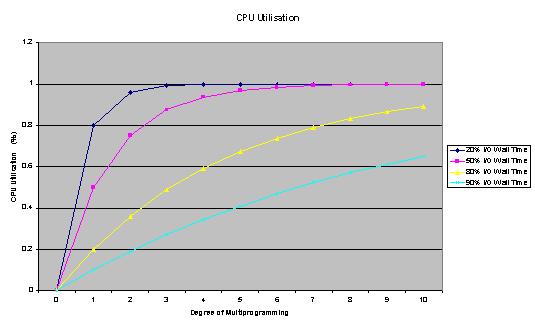

Why multiple-processes? Check this
table of latencies.
We can use the CPU while RAM, disk, and network access are
occurring.
Two types of parallelism:
Pseudo-parallelism: on one CPU, gives the appearance that
processes are running simultaneously.
Real parallelism: with multiple CPUs, processes
do run simultaneously. (But not all of them,
usually: e.g., four CPUs on my Mac, but 392 processes.)

The illusion of parallelism is produced by continually
switching the CPU between processes. These switches are
expensive.
There is no real difference conceptually between what a
single CPU running 100 processes does been a four core CPU
running 400 processes. So here we will just look at the
single CPU situation.
It is important to know that from the point of view of a
single program, multiprocessing renders the behavior of the
program nondeterministic. The program cannot be certain how
frequently it will get the CPU. This can become crucial
with programs doing things like playing a video, and
really, really crucial, if the program is monitoring the
state of a nuclear power plant or a patient's vital signs
in the hospital.
A process is a program in action.
How processes are created:
Technically, in all cases, 2 is how new processes
are created.
At boot time, a windowing system or command shell may be
started. But the system also starts daemons that listen on
ports for mail or web page requests, scan for viruses,
handle print requests, etc.
The book claims that the batch situation only applies on
mainframes. But UNIX has a cron facility for running batch
jobs, and Windows has a Task Scheduler.
UNIX: fork and exec pair start process. After fork,
the child is a copy of the parent. It can then manipulate
file handles, and then exec a new program in its process
space.
Windows: CreateProcess is the single call that
accomplishes both of the above tasks. Win32 has 100 other
calls for managing processes.
How processes terminate:
Very often, a process and because it has finished its work.
The user clicks "Exit" on a word processor, or a compiler
finishes compiling a program. In UNIX, the process executes
the exit system call, and on Windows,
ExitProcess.
The second case is really a special instance of the first:
if we try to compile foo.c and no such file exists, the
compiler exits with the complaint "No such file." but it
may set a different exit code.
In the third case, the process has done something naughty,
and the OS kills it: it tried an illegal instruction (e.g.,
switching into kernel mode without executing a system call)
or accessed memory not its own, or dividing by zero.
The fourth case is when one process kills another with a
system call and process ID. In UNIX, the call is
kill, and in Windows, TerminateProcess. In
neither case does this kill processes created by the murder
victim. (In some OSes it will.) The murderer needs the
right permissions, e.g., a user process can't kill a kernel
process, and a (non-root) user can't kill the process of
another user.
UNIX processes form a hierarchy: a parent spwans child
processes, which spawn grandchild processes, etc. For
instance, a signal may be sent to the whole process group.
Windows has no such process hierarchy.

In this case, we can usefully turn to the Wikipedia page on the process control block .

We look at CPU usage from a probabilistic viewpoint, and
try to see what the likely rate of CPU usage is. We
get a formula, where p is the fraction of time an
average process waits for I/O, and n is the number
of processes:
CPU utilization = 1 - pn